History of the Irish Herring
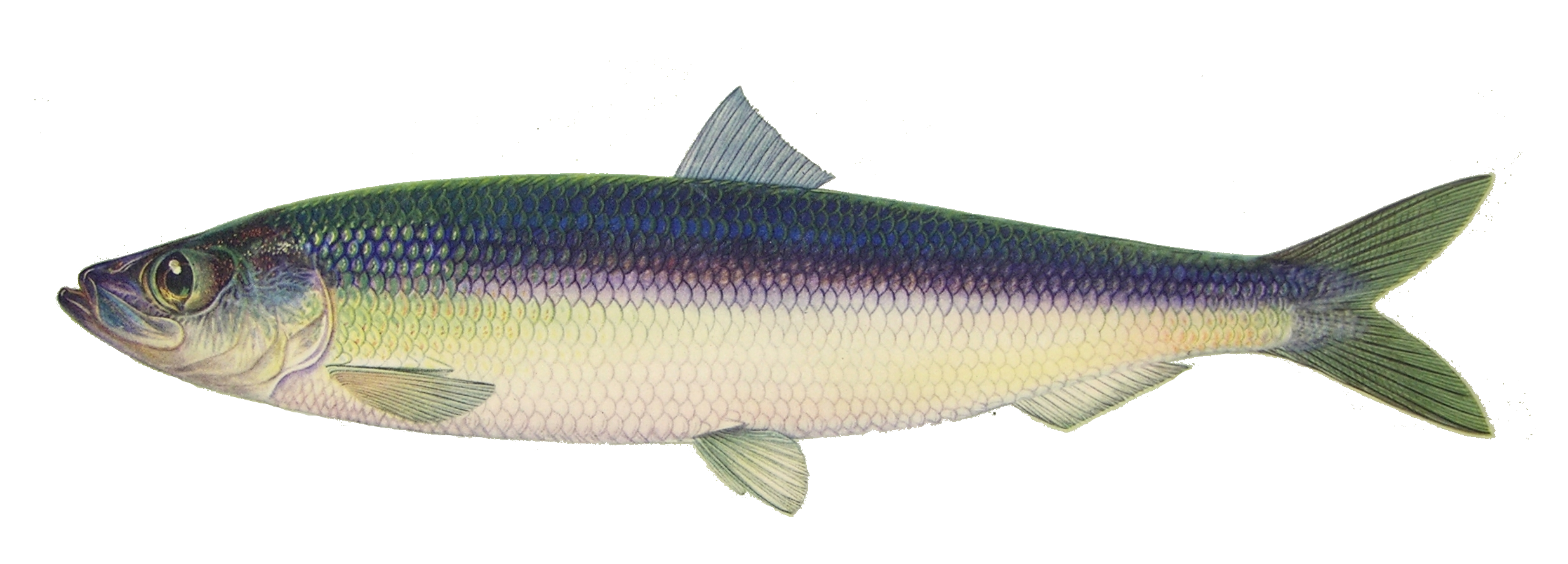 Herring has played a fundamental role in European history both socially and economically. During the Middle Ages, herring prompted the founding of many cities such as Great Yarmouth, Amsterdam, and Copenhagen.
The fish has been called the "silver of the sea", and its trade has been so significant to many countries that it has been regarded as the most commercially important fishery in history.
Herring has played a fundamental role in European history both socially and economically. During the Middle Ages, herring prompted the founding of many cities such as Great Yarmouth, Amsterdam, and Copenhagen.
The fish has been called the "silver of the sea", and its trade has been so significant to many countries that it has been regarded as the most commercially important fishery in history.
Although the origin of the term "herring" is somewhat unclear, it is thought to derive from the Old High German 'heri' meaning a "host, multitude", in reference to the large schools they form.
Ireland is no exception when it comes to this shoal forming pelagic fish belonging to the Clupea family. Herring fishery has played a huge part on the emerald island and formed the history of many coastal Irish villages and towns. This is still reflected in place names such as Balscadden Village (gaelic Baile na Scadán - The Town of the Herrings).
Since Ireland’s herring history is highly complex and one can be dragged from one rabbit hole into the next while investigating this important relationship, Food Smart Dublin asked in-house expert Patrick Hayes. The historian studied Ireland’s fisheries in the medieval and early modern time for his recently successfully defended PhD thesis and gave us his carefully considered view on the herring fishery for this period. We greatly appreciate Patrick's input and are happy to forward any questions to him that may arise while you dive into Ireland's history of herring.
The beginning of herring fishery in Ireland
The exact beginning of the herring fishery in Ireland is not known. However, zooarchaeological evidence has allowed researchers to pinpoint the birth of intensive marine fishing in England, and the wider European region, to the beginning of the tenth century AD. This research has shown a shift away from freshwater fishing and a rapid increase in sea fishing around 1000 AD. Barrett and co-workers (2004) have coined this transition the ‘fish event horizon’. Herring was the first species to be widely exploited in the first millennium; cod, hake and other gadid catches started to come in around the thirteenth to fourteenth centuries.
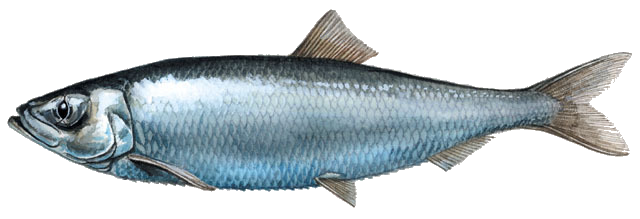
In the Irish case, the first documentary evidence for commercial fisheries comes from the thirteenth century. For example, in 1258 the Irish Chancery records show several shipments of fish, including herring, being sent to Wales to supply the English army fighting there. An entry from the Irish Annals from LC1217.2 describes how fishers from Port-Lairge (Waterford) and along the coast from Loch-Carman (Wexford) to Doire Choluim Chille (Derry) all travelled to Manainn (The Isle of Man) to fish. The species targeted on the Manx coast was the herring. Modern research by Dickey-Collas and co-workers (2001) shows that spawning herring populations regularly migrate between Irish and Manx shores. A similar spawning pattern in the thirteenth century could have driven medieval fishers from their fishing grounds in Ireland to seek out the herring in the Isle of Man. And indeed the Manx fishery offered important employment and an income stream for the Irish.
The prosperity of the herring fishery
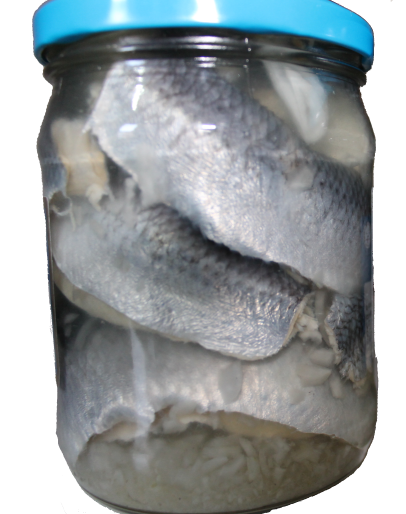
During the fifteenth and sixteenth centuries, several Irish towns relied on herring fishery and its subsequent trade for prosperity. The fishery was mainly carried out off the coasts of Counties Down, Louth, Dublin and Wicklow and generally along the East coast of Ireland by small boats inshore and some larger boats from Carlingford. But also Waterford, Cork and Youghal were actively involved the herring fishery.
As an English outpost on the edge of the Pale, Carlingford is an excellent example how herring shaped this town. In the fifteenth and sixteenth centuries, it hosted a seasonal herring fishery each year. The town seems to have experienced a period of considerable prosperity in the fifteenth century. This is suggested by the survival of several impressive buildings from this period, including the tholsel and mint (an elaborate merchant’s residence). These structures were likely built with the proceeds of the towns herring fishery.
Many of the Skerries and Ballbriggan wherries (traditional cargo boats) were profitably engaged in carrying fish (mainly herring) between the Isle of Man, Dublin and Liverpool.
The Herring Season
The Manx fishery usually went on from July to the end of October and after the herring season was over, the Irish fishermen were usually engaged as farmers, mechanics and labourers.
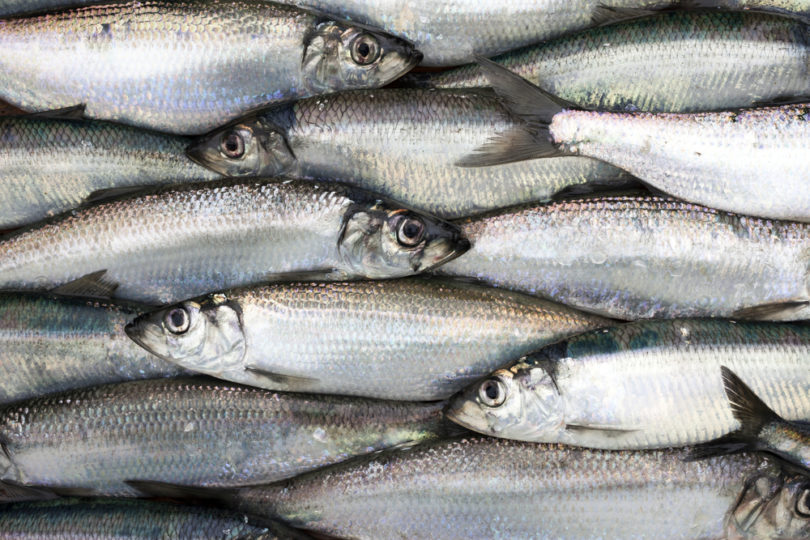
And still, Howth in Co. Dublin developed into a herring port around 1860. It was small and uncertain before this time, but Cornish and Scottish boats began to operate from the port, and the fishery rapidly became one of great importance. But in the end, this didn’t last long and by 1887 most herring fishing activity had ceased in this port.
The 1930s saw better herring times again and especially Wexford seemed to have been very active as remembered in the National Folklore Collection, Dúchas UCD The Schools’ Collection, Volume 0880, Page 201 by Emma Owens:
There was a lot of herring fishing going on in Wexford Bay which seemed to have been introduced by the Danes. These season for herring fishing here was also different to other places around the island as it lasted from October to January in the 1930s. When the Danes brought fishing to Wexford the town was very different from what it is now. The fishing people lived mostly up in the Faythe and William Street, and it seemed a different part of the town.
Now the people have spread out but they have not lost the herring fishing which is a very good thing. The fishers go out every night almost, during the season, which lasts from October to January.
During a good season the herring are sometimes as cheap as sixpence a dozen.
When the herring are brought in at night they are very nice to look at, they are like a lot of coloured glass stuck together.
There are many other great and fascinating stories about the herring and its deeply rooted Irish history on the Dúchas website. Visit Dúchas stories on herring if you want to find out more.
Herring wars
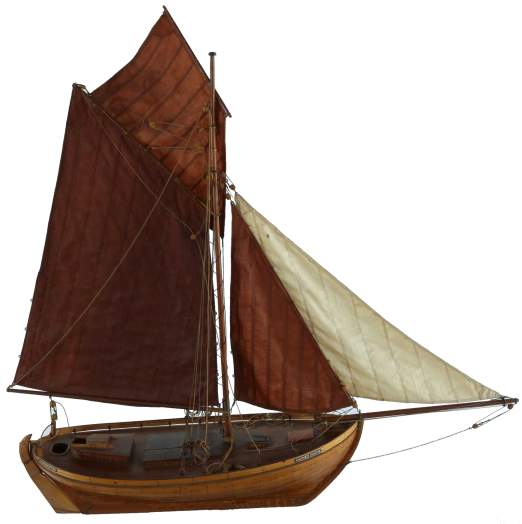
There were no specific wars fought over herring, but since the fifteenth century (and maybe earlier) there has been an intense competition over access to fishing resources on the Irish coast, including herring.
From at least the fifteenth century visiting fishers were an essential part of the maritime economy in the early sixteenth century, and many Gaelic Irish and Old English areas had complex systems to tax and facilitate these operations. English fisheries regularly visited Ireland too, but the English authorities were always wary of the interaction between continental fishers and the Gaelic Irish. From at least 1465, attempts had been made to introduce licences to regulate foreign vessels. However, the concern with these foreign fishers became even more significant after 1534. In 1535 an article was proposed in the Irish Parliament that stated, ‘the fishing of Ireland is a great commodity which strangers haunt and carry away into Spain, France and Scotland’. It further specified that no ship could leave the country before first paying customs duties.
Later in the mid-sixteenth century, the English authorities began to claim fishing resources more aggressively. Again, Carlingford is a good example to illustrate this: Carlingford’s prosperity was servery impacted by successive violent conflicts between the English and Gaelic Irish in Ulster. The town was described as ‘extremely impoverished’ by 1575. The Nine Years War brought some reprieve to Carlingford, as the English army used it as a hub for importation. However, after the war the English army left the town and the herring fishery that had traditionally sustained it never resumed, leaving Carlingford largely abandoned by 1602, later in 1606 it was described as one of the ‘poor towns’ of Ulster.
The uniqueness of the Irish herring fishery
Patrick believes that a unique aspect of the Irish herring fishery was the involvement of other nations in the fishery. From the earlier period English, Scottish, Spanish, and French fishers all visited Irish waters to exploit the herring. By the end of the sixteenth century, the Spanish and French had been driven out by the English, but visiting fishers from Great Britain continued to play a vital role in the industry. Today, the sharing of fishing resources in Irish waters continues with the European Union’s Common Fisheries Policy.
The collapse of the herring fishery

The fishery collapsed several times throughout history. The collapse in the late sixteenth century was likely due to persistent conflict in Ireland, the influx of fish from Newfoundland and possible climate anomalies.
The collapse of the herring fishery in the North Sea during the 1970s was largely caused by over-exploitation, followed by periods of poor recruitment. In 1977 an embargo was forced upon the fishery until the stock eventually recovered and the fishery was re-opened in 1983.
By 1996, exploitation had increased to such a level that stricter measures were introduced to reduce fishing mortality.
In 2014, Ireland gained its first herring MSC certification for the Northern Ireland Pelagic Sustainability Group (NIPSG). This means it is recognised as a sustainable and well managed fishery. Today, 12 herring fisheries in the North Atlantic and the Baltic Sea hold MSC certification for the species Clupea harengus with over 1000 products carrying the MSC label.
The Irish always have appreciated their silver darlings which have not only shaped Ireland’s economy but cultural identity over centuries. It seems this appreciation is gone bar a few and it is extremely difficult to get your hands onto fresh herring. If you don’t know a fisher who catches ‘de heddin’ for sentimental value and to secure a few nice dinners, you’re almost certainly out of luck. Fishmongers don’t stock fresh herring, because there is no demand.
One can only hope that the herring will come into fashion again and future generations sing the fish’s praises like Ireland’s infamous poet Jonathan Swift once did:
Poetry
- Herrings –
- Be not sparing
- Leave off swearing
- Buy my herring
- Fresh from Malahide
- Better never was tried.
- Come, eat them with pure fresh butter and mustard,
- Their bellies are soft, and as white as a custard,
- Come, sixpence a dozen, to get me some bread,
- Or, like my own herrings, I soon shall be dead.

Historical Herring Trivia
Did you know that dried & salted herring was the Irish staple food during lent? On Good Friday people usually fasted while they whipped the herring out of town the next day in anticipation for Easter celebrations.
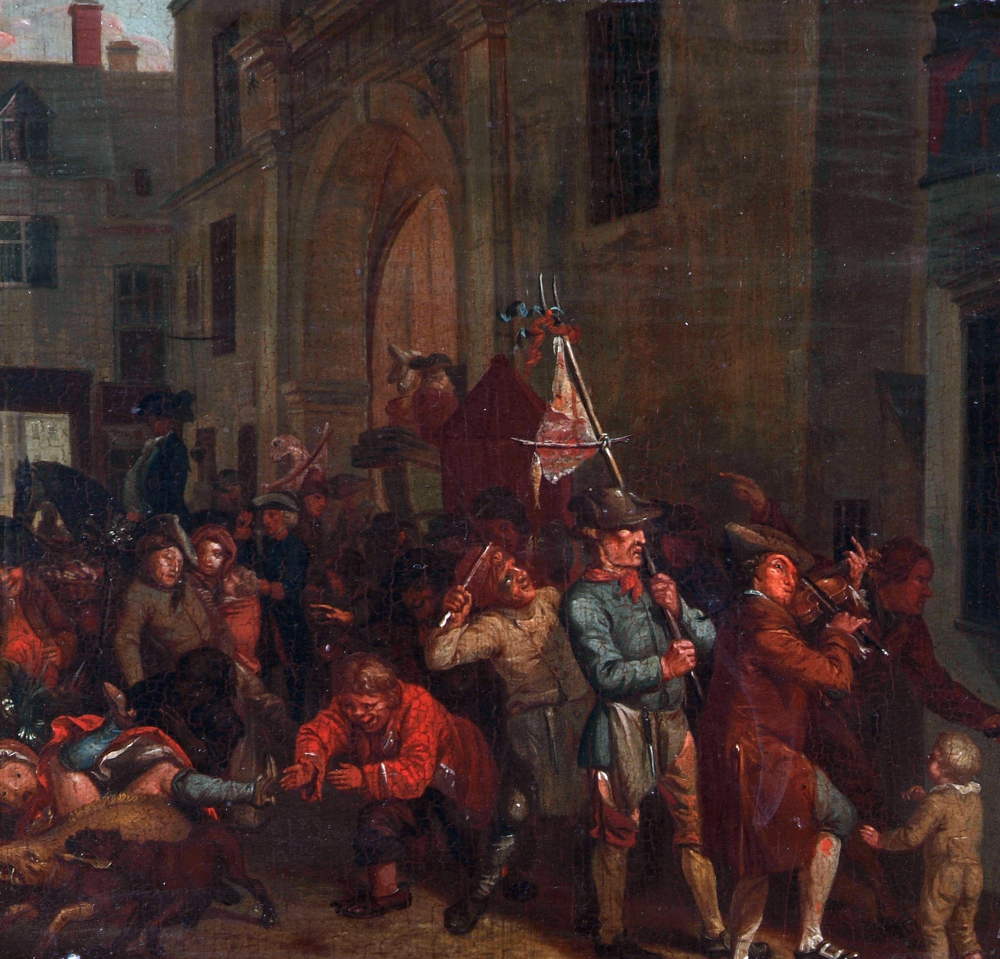
Francis Day tells us in his book "The Fishes of Great Britain and Ireland, 1880-1884" that a Manxman going to fish for herring would always take a dead wren with him. The logic behind this was that there had been a sea-spirit which haunted herring tackle and brought on storms, but which had finally changed itself into a wren and flown off; therefore, the presence of a dead wren signified that all would be well when fishing for herring.
Ecology of herring
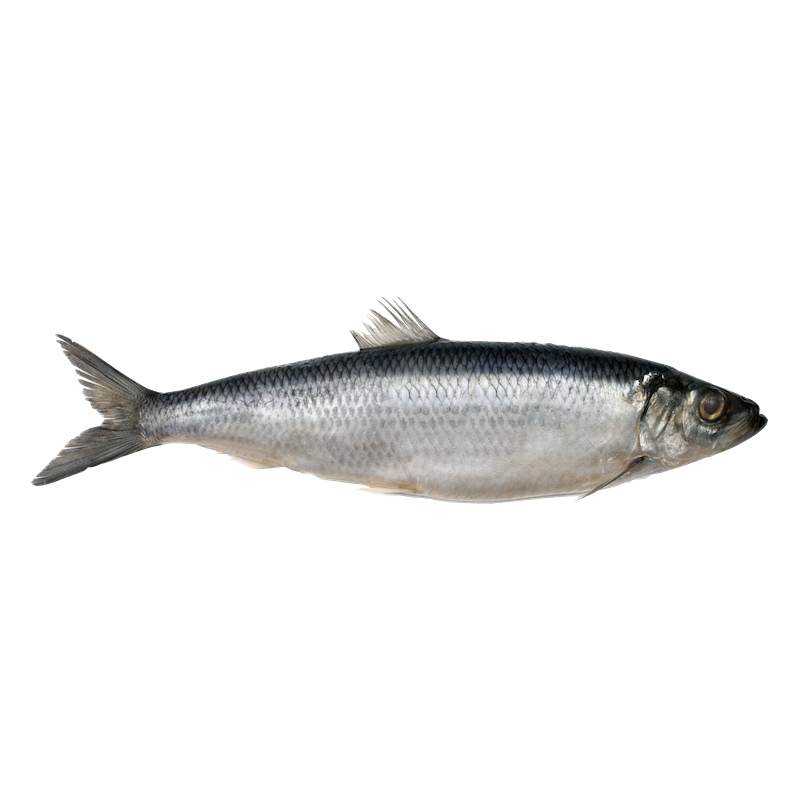
Did you know that herring-like fish are the most important fish group on earth? An excellent source of Vit D & omega-3 fatty acids, they have been a staple for humans for millennia. Given this importance, herring is also one of the most and best studied marine fish species world-wide.
Herring types
The type genus of the herring family Clupeidae is Clupea and contains three species: the Atlantic herring (Clupea harengus) found in the north Atlantic, the Pacific herring (Clupea pallasii) found in the north Pacific, and the Araucanian herring (Clupea bentincki) found off the coast of Chile. There are suggestions for some subspecies divisions for both the Atlantic and Pacific herring, but their biological basis is still somewhat unclear.
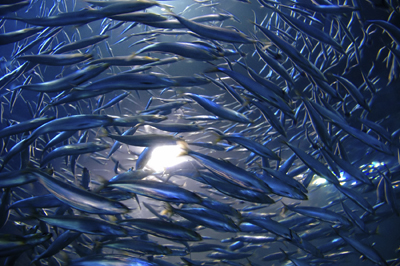
What is very well established however, is that there are several different stocks of herring in the Atlantic and at least one stock spawns in every month of the year. They all spawn at different times and places, but they are commonly referred to as the spring-spawning and the autumn-spawning stocks. For example, North Sea herrings spawn at a depth of down to 200 m in autumn. Unusually for a marine fish, eggs are deposited on the bottom in discrete gravel beds, but also stick to rocks, seaweed beds and sand with their outer mucus layer. Herring eggs are also consumed by some gadoid species. In the waters around Ireland the main spawning grounds for herring are off the Donegal and Mayo coasts, and inshore along the south and west coast including Dunmore East and Cork Harbour.
Herring reach full maturity by the age of 2-3 year. They are not particularly fecund compared to other pelagic fish although they produce quite a few eggs. Females may deposit from 20,000 to 40,000 eggs, according to age and size, averaging about 30,000. In sexually mature herring, the genital organs grow before spawning, reaching about one-fifth of its total weight.
Reproduction and life cycle of herring
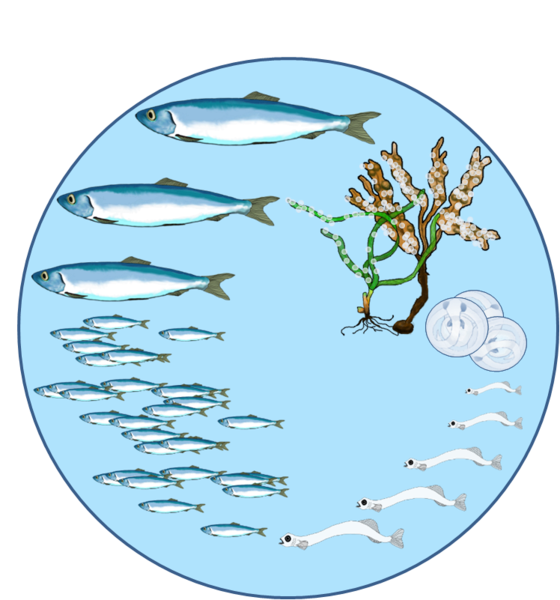
The individual eggs are 1 to 1.4 mm in diameter, depending on the size of the parent fish and also on the local race. Incubation time varies with temperature (about 40 days at 3°C, 15 days at 7°C, or 11 days at 10°C) and eggs die at temperatures above 19°C.
The size of Clupea harengus can vary greatly: e.g. the subspecies, in Baltic herring is by far the smallest (14-18cm) while the herring from the Atlantic can grow up to 45cm in length and weigh up to 1.1kg.
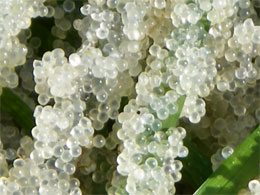
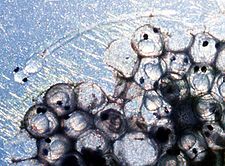
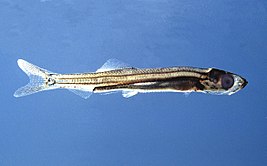
The young herrings feed on phytoplankton, and as they mature, they start to consume larger organisms such as copepods which is their main food. But they also consume arrow worms, pelagic amphipods, myphids and krill. Herrings are pelagic schooling fish (fish that live in the water column rather than at the seabed) and are known to migrate to distant feeding grounds, often found in mixed aggregations with other herring stocks.
Herring have a very refined hunting system. They swim in a grid where the distance between them is the same as the jump length of their prey. The length of the jump is fairly constant. A copepod can dart about 80 times before it tires. After a jump, it takes the copepod about 60 milliseconds to spread its antennae again. This time delay is fatal for the copepod, as the almost endless stream of herring allows one herring to eventually snap up the copepod. Especially juvenile herring hunt the copepods in this synchronised way, because a single juvenile herring could never catch a large copepod.
Herrings themselves are a central food source for higher trophic fish as well as seabirds, seals and other marine mammals.
Nutritional value of the herring
The chemical composition of herring varies considerably with the season and the breeding cycle; the fat content of herring may be less than 1 per cent immediately after spawning, and more than 20 per cent as spawning time approaches again. The water content decreases as the fat content increases. In addition the protein content varies with water content; as the water content increases, so the protein content rises a little.
Herring Trivia:
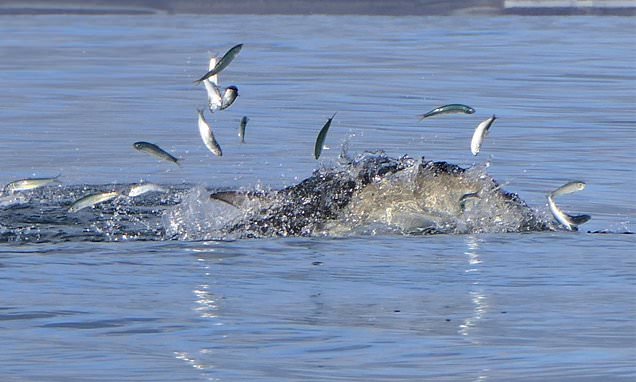
Herring fart to communicate! A 2003 study revealed findings that herrings use a high-frequency sound only audible to herring to form protective shoals to help them stay safe. This noise is produced by herrings swallowing air from the surface and releasing it as bubbles through a small opening near their anus – making it sound like high-pitched farts. This humorous discovery earned the Swedish scientists involved an Ig Nobel Prize, an award given to “honour achievements that first make people laugh, and then make them think,” as the official website explains.
This exact noise also caused great confusion in the 1990s between Sweden and Russia concerning an alleged submarine crossing a delicate border space in the Baltic Sea over the years of the Iron Curtain. The Swedish scientists soon discovered it was herrings farting and not Russian submarines they heard in that area.
Herring making ‘noise’ has been known for hundreds of years.
Francis Day (The Fishes of Great Britain and Ireland, 1880-1884) writes:
"The noise made by herrings when captured is peculiar, and has been likened to various things – to the cry of a mouse, to the word “cheese”, a sneeze, or a squeak."

